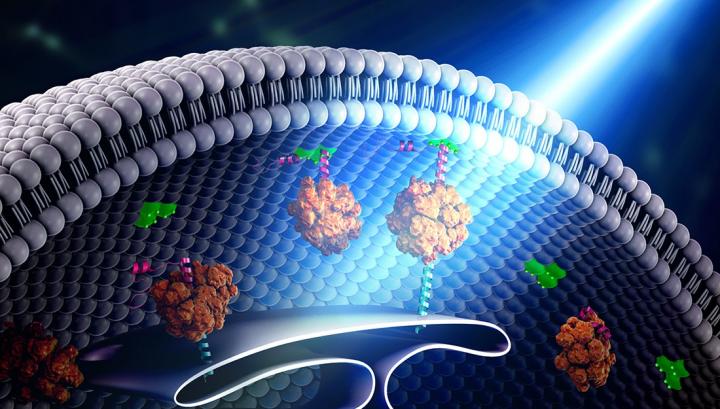
Optogenetics Used to Control Interorganellar Communication
Researchers are using optogenetics to tune communication between organelles within living cells. The optogenetics tools are being used to control the proteins that form the bridge between organelles, and to govern the length of the bridge at the nanoscale. Bridge length influences the critical functions of the cell; when it is disrupted, metabolic dysfunction and cell death can occur.

Proteins are the building blocks of the 'bridge' between organelles in the cell. Courtesy of Yun Huang and Yubin Zhou.
Membrane tethering is the process used for bridging the gap between
organelles at membrane contact sites (MCS). To manipulate this
tethering, Texas A&M University researchers have created an
optogenetic toolkit, called OptoPB, to enable control of protein
translocation and inter-membrane tethering at MCSs.
“For the first time, we’re able to build bridges of different lengths in living cells to connect subcellular compartments with great temporal and spatial control,” said professor Yubin Zhou.
The team used the genetically encoded OptoPB tools as scaffolds for grafting lipid-binding domains to dissect the molecular determinants that govern protein–lipid interactions in living cells.
Researchers further demonstrated the use of OptoPB to photomanipulate protein translocation toward the plasma membrane for the reprogramming of lipid metabolism. They showed that when tethered to the endoplasmic reticular (ER) membrane, OptoPB could be used to reversibly phototune the gap distances at nanometer scales between the two organellar membranes at MCSs and to gauge the distance requirement for the free diffusion of protein complexes into MCSs.
“The optogenetic tools developed in the study might hold great promise to rescue . . . detrimental conditions with a simple pulse of light,” Zhou said. “The potential impact is likely to be broad and profound, in that it allows the use of non-invasive light, for the first time, to study and manipulate these subcellular structures that are considered to be one of the most challenging and elusive in mammalian cells.”
Although the team’s initial work focused on the connection between the plasma membrane of the cell and the ER organelle, in the future the researchers plan to broaden their investigation to include other places of connection, such as between the ER and the mitochondria.
The researchers believe that their optical tools could find broad applications in the non-invasive, remote control of protein subcellular localization and interorganellar contact sites that are critical for cell signaling.
“These tools will furnish untapped potentials for scientists to conveniently rewire cell signaling, control protein-lipid associations, perturb intracellular communication among organelles and tweak the motion and behavior of proteins embedded within biological membranes,” Zhou said. “It opens untold new research areas, and we believe this work could have wide implications for multiple disciplines.”
The research was published in Chemical Science (doi: 10.1039/C7SC01115F).
Published: September 2017